801
Zanachka probable and improbable partner
Almost seven hours of driving from San Diego, kaleidoscopic change of landscapes (seen even sandy desert), and here we are in the country stony fields and cactus - Arizona, more precisely on its south, in Tucson. No doubt this is one of the capitals of American aircraft, such a number of aircraft at the same time in one place you will not see anywhere else. It is the largest US Aerospace Museum, north of the city is the base of the storage of private and commercial aircraft Pinal Airpark, and in the southern part of the city is Air Force Base Davis-Monthan and the famous 309th group on maintenance and repair of aerospace engineering (309th Aerospace Maintenance and Regeneration Group, AMARG) aka Boneyard - point of our aspirations, still one of my dream to fulfill.
60 photos, and text.

1. On the next day we will visit the museum and bus tour to the territory of the base of storage. And yet, have not even stayed at the hotel, we go round the perimeter of the base of the machine, estimating the size and number of standing there technology. I must say that even from behind the fence, the size and number is quite impressive. It is believed that in the conduct of the 309th group is about 4,400 aircraft and about 40 spacecraft, the total value of the property exceeds thirty five billion dollars (wiki).

2. From the main road, the base is not visible, it is pretty well covered auxiliary buildings and grounds, and the highway, coming directly from the database, runs in a hollow, so that you can see through the fence just to the south and east, where apparently there are private office shredding. On the territory of the accumulated suspiciously large number of ancient anti-aircraft tracker, I do not whether the project for the Brazilian?

3. More Trackers.

4.

5. And it already the next day - a bus tour. On the tour must be recorded in the museum, the list of names, you must present a passport or driving license. This is the usual procedure when visiting existing military facilities. To photograph the entrance to the base and infrastructure is prohibited, but especially no one checks. Unfortunately the bus quite tinted windows, may be a bright, sunny day and it was good, but today overcast toning and only worsens the already not brilliant conditions for shooting.
CPR overcame and now they are the first parking lot. Almost all aircraft in varying degrees of tight white film, all the holes closed. In the picture - parking F-16 fighters, judging by the numbers, many of them quite recently flew. Please note that the planes are just standing on the ground without a concrete slab under the wheels.
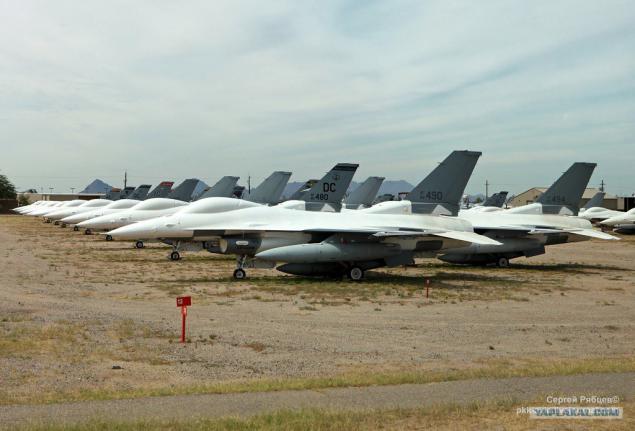
Air Force Base Davis-Monthan founded in 1925 and named in memory of the residents of Tucson - a military pilot of World War I - Cemyuele Davis (died in 1921) and Oscar Montaigne (died in 1924). In 1940 the base was expanded, crews are preparing bombers. After the war, Davis-Monthan was selected as a cemetery of planes (The Boneyard), due to the dry climate and hard soil, allows you to store aircraft on unprepared sites. However, already in 1946, with the beginning of the Cold War, we are re-established strategic aviation combat units - two air group «Boeing B-29 Superfortress». Currently, the air base also acts - all day and evening, we watched military training flights of transport "Hercules".
However, the database is not known for this military unit, and the so-called 309th group on maintenance and repair of aerospace engineering (Eng. Abbr. AMARG) - the largest repository of canned aircraft belonging to both the Ministry of Defense, and other US government services (Coast Guard, NASA, and so on. D.). 309th Group was formed in 1946 as a 4105-th group of army aviation, the allocation of the US Air Force as a separate branch of service (1949) became a 3040-m aviaskladom, the current name is established in May 2007. The 309th Group employs more than 550 people, basically - civilian specialists.
Annually deposited receives about 400 pieces of equipment, and the same is eliminated (sold to friendly countries or destroyed). This number does not include the fleet, disposed of in separate interstate agreements (only START-I to the base have been destroyed, 365 bombers Boeing B-52 Stratofortress). When setting for storage from all machines dismantled weapons and sensitive equipment. Fuel systems are drained and pumped oil, forming a protective film.
Park equipment based on divided into 4 categories:
1. Long-term preservation (potentially combat-ready machines)
2. Short-term preservation (potentially combat-ready machines)
3. Planes - donor parts (gradually understand, unfit for combat)
4. Equipment for sale
6. Remove from aircraft engines in containers - based on contains more than 350,000 items of various parts, which at first may need to be delivered to customers.

7. Motors in uncovered containers and wooden boxes.
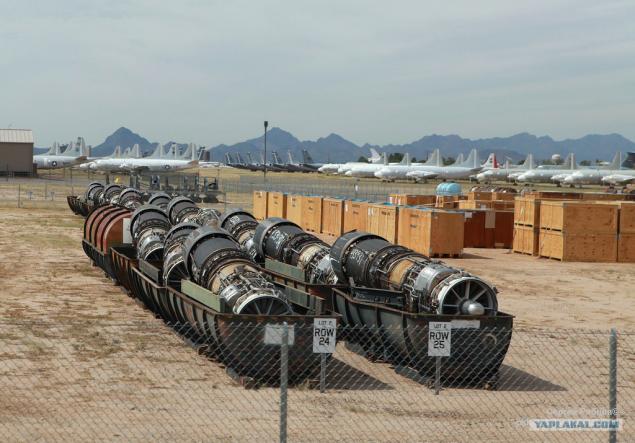
Each year, experts 309th group treated more than 19,000 units of various parts (wiki) total value in the region of US $ 600 million. In addition, 309 second group is engaged in repair of aircraft, some of them returning to duty. Therefore, every dollar invested in AMARG taxpayer returns to the treasury US $ 11, this is the only "profitable" military unit.
8. The series of engines.

9. sucked into the film GE TF39 engines of transport aircraft C-5 Galaxy.

10. Along these objects bus is moving quite quickly, barely have time to do more or less normal pictures.

11. The bus takes us to the alley, where, because once stored on the basis of planes assembled local museum.

12. The white film turns aircraft into any strange objects of modern art, but is shaped like a flying machine. Like this one, almost completely tightened film OH-58 helicopter.

13. The helicopter "Iroquois", as well as an object of "Film" art.

14. The helicopter "Sea Hawk".

15. The bus crawls slowly between exhibits, the guide is trying in good faith to talk about each machine, tourists slowly yawn. And have something - all these airplanes and helicopters can be seen in the museum across the street, in the normal form, with no film and tinted glass. But apparently this is payment for this tour. As in Turkey - first we visit the palace, and then store coats :) Sturmovik A-4 "Skyhawk" with red stars - "aggressors" from the "Top of Ghana."

16. Another A-4, no stars.

17. A-7 "Corsair".

18. Out of boredom start photographing planes on long rows. That health and transport C-9 "Nightingale."

19. KC-135 tanker.

20. And this is again a museum specimen - fighter F-101 Voodoo.

21. There are also interesting machines of this kind of training Fairchild T-46 Eaglet. At one time it was considered revolutionary training machine and the program of its creation is quite ambitiously called Next Generation Trainer (NGT). However, in a series of aircraft did not go, the program was closed.

22. And that the training Cessna T-37 Tweet luckier he produced commercially, it has done some fighting the assault version in Vietnam.

23. Lockheed Orion with an unusual antenna on the keel.

24. KC-10 tanker - Transport removed the hatch hole neatly sealed.

25. One of the presidential VC-135.

26. Hooray tyagomotina to the museum has ended, the bus picks up speed, parting the pair of missile sites - head of the rocket Titan III ...
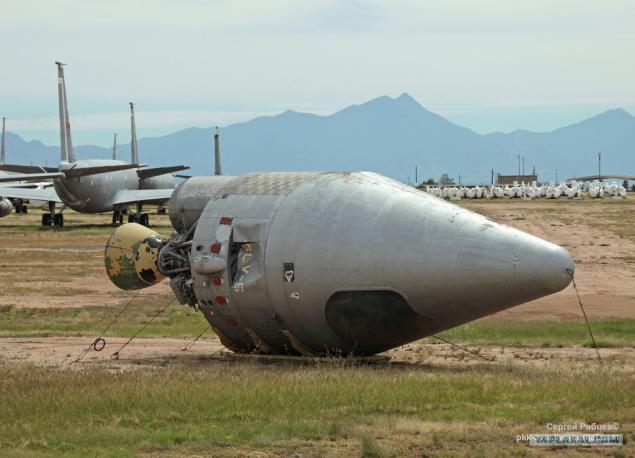
27. ... and unknown to me a rocket with a skeleton sitting on the nose.

28. In the rest of the base of the bus is moving quite quickly, the guide moves to the patter, something to consider in detail just no time. Around the field C-135 aircraft of various modifications. Tanker, transport, reconnaissance.

29. Rows tails.

30. Fields cluttered C-130 transporters.

31. ... and field the F-16.

32. These machines have no wings and feathers, but more on their chassis. Nearby you can see the boxes packed with spare parts.

33. And these are missing, and the chassis, the fuselage mounted on a wooden base. In the background are also neatly labeled boxes with the removed parts.

34. The whole group "legless".
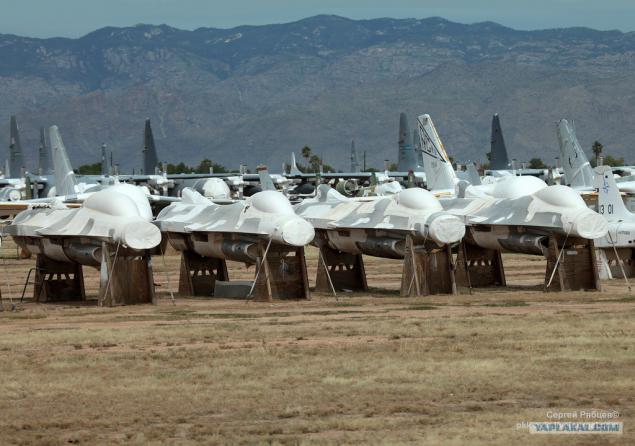
35. Helicopters HH-3 in varying degrees disassembled.

36. Viking antisubmarine on supports.
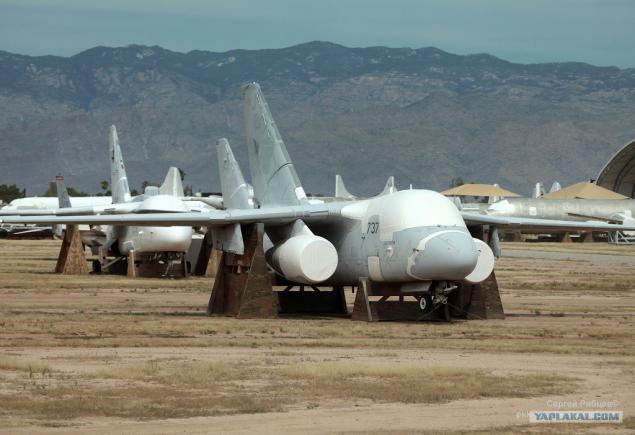
37. Corsair double, until recently, these gunships flew to Greece.

38. Corsair single.

39. Harrier.
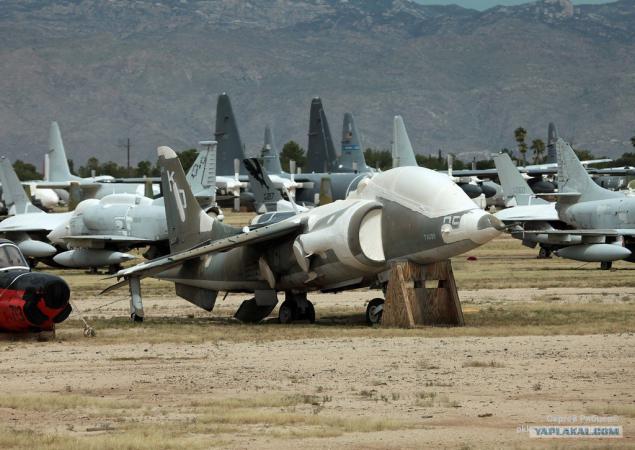
40. Hawk with removed radars.
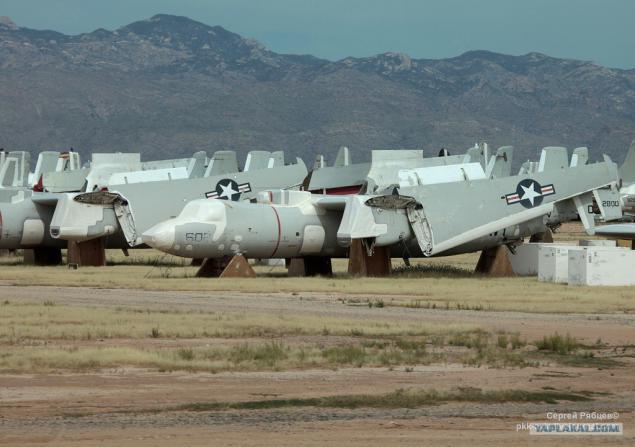
41. Entire field patrol Orion.
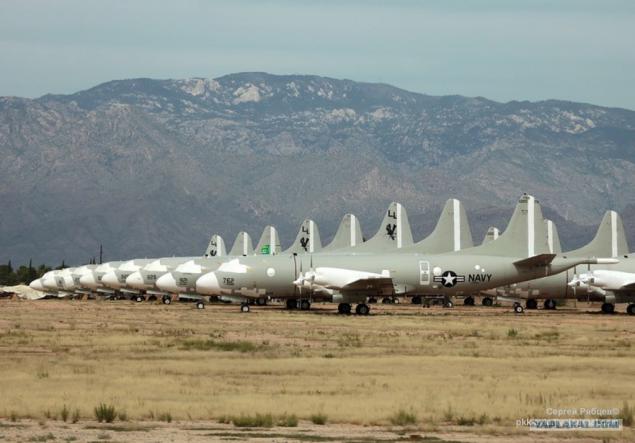
42. Again, the C-135 in various incarnations and degrees disassembled.
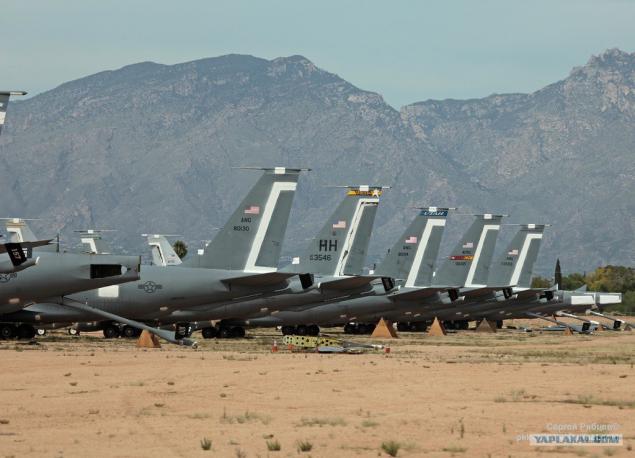
43.

44.

45. And this is a larger appliances - written off transports C-5 Galaxy.

46. As if the dinosaurs tower over rows of "Greyhound" and "Hornet".

47. Parking survivors "Phantoms."
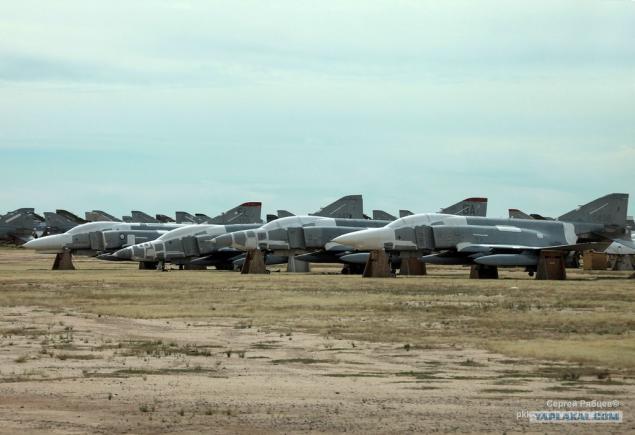
48. Few of missile technology.

49. Rows "Hornet" in the background you can see the keel of a lone bomber B-52. Before them there were many, and now, apparently all drank.

50. The line of T-38 training.

51. "The Iroquois»,

52. ... again "the Iroquois."

53. Marine workhorse - helicopters «Sea Knight», now the Marines fly to «Osprey».

54. "SiStelliony" too Marines.

55. Once again, the mighty "Galaxy". Previously, it seemed that these planes will fly forever.

56.

57. The storage area of the B-1 how to shoot could not, unfortunately, moving at a gallop.

58. Lastly, the final picture of endless rows of C-130 on a background of the Arizona mountains, the tour ends, close the CPT, the guide advises remove cameras ...

59. A little rest in the museum café. Sandwich, Coca-Cola and continue visiting the museum. It is a huge and very interesting.
Source All
garry21 lower post is not a minus, he fuck with the number of.

60 photos, and text.

1. On the next day we will visit the museum and bus tour to the territory of the base of storage. And yet, have not even stayed at the hotel, we go round the perimeter of the base of the machine, estimating the size and number of standing there technology. I must say that even from behind the fence, the size and number is quite impressive. It is believed that in the conduct of the 309th group is about 4,400 aircraft and about 40 spacecraft, the total value of the property exceeds thirty five billion dollars (wiki).

2. From the main road, the base is not visible, it is pretty well covered auxiliary buildings and grounds, and the highway, coming directly from the database, runs in a hollow, so that you can see through the fence just to the south and east, where apparently there are private office shredding. On the territory of the accumulated suspiciously large number of ancient anti-aircraft tracker, I do not whether the project for the Brazilian?

3. More Trackers.

4.

5. And it already the next day - a bus tour. On the tour must be recorded in the museum, the list of names, you must present a passport or driving license. This is the usual procedure when visiting existing military facilities. To photograph the entrance to the base and infrastructure is prohibited, but especially no one checks. Unfortunately the bus quite tinted windows, may be a bright, sunny day and it was good, but today overcast toning and only worsens the already not brilliant conditions for shooting.
CPR overcame and now they are the first parking lot. Almost all aircraft in varying degrees of tight white film, all the holes closed. In the picture - parking F-16 fighters, judging by the numbers, many of them quite recently flew. Please note that the planes are just standing on the ground without a concrete slab under the wheels.

Air Force Base Davis-Monthan founded in 1925 and named in memory of the residents of Tucson - a military pilot of World War I - Cemyuele Davis (died in 1921) and Oscar Montaigne (died in 1924). In 1940 the base was expanded, crews are preparing bombers. After the war, Davis-Monthan was selected as a cemetery of planes (The Boneyard), due to the dry climate and hard soil, allows you to store aircraft on unprepared sites. However, already in 1946, with the beginning of the Cold War, we are re-established strategic aviation combat units - two air group «Boeing B-29 Superfortress». Currently, the air base also acts - all day and evening, we watched military training flights of transport "Hercules".
However, the database is not known for this military unit, and the so-called 309th group on maintenance and repair of aerospace engineering (Eng. Abbr. AMARG) - the largest repository of canned aircraft belonging to both the Ministry of Defense, and other US government services (Coast Guard, NASA, and so on. D.). 309th Group was formed in 1946 as a 4105-th group of army aviation, the allocation of the US Air Force as a separate branch of service (1949) became a 3040-m aviaskladom, the current name is established in May 2007. The 309th Group employs more than 550 people, basically - civilian specialists.
Annually deposited receives about 400 pieces of equipment, and the same is eliminated (sold to friendly countries or destroyed). This number does not include the fleet, disposed of in separate interstate agreements (only START-I to the base have been destroyed, 365 bombers Boeing B-52 Stratofortress). When setting for storage from all machines dismantled weapons and sensitive equipment. Fuel systems are drained and pumped oil, forming a protective film.
Park equipment based on divided into 4 categories:
1. Long-term preservation (potentially combat-ready machines)
2. Short-term preservation (potentially combat-ready machines)
3. Planes - donor parts (gradually understand, unfit for combat)
4. Equipment for sale
6. Remove from aircraft engines in containers - based on contains more than 350,000 items of various parts, which at first may need to be delivered to customers.

7. Motors in uncovered containers and wooden boxes.

Each year, experts 309th group treated more than 19,000 units of various parts (wiki) total value in the region of US $ 600 million. In addition, 309 second group is engaged in repair of aircraft, some of them returning to duty. Therefore, every dollar invested in AMARG taxpayer returns to the treasury US $ 11, this is the only "profitable" military unit.
8. The series of engines.

9. sucked into the film GE TF39 engines of transport aircraft C-5 Galaxy.

10. Along these objects bus is moving quite quickly, barely have time to do more or less normal pictures.

11. The bus takes us to the alley, where, because once stored on the basis of planes assembled local museum.

12. The white film turns aircraft into any strange objects of modern art, but is shaped like a flying machine. Like this one, almost completely tightened film OH-58 helicopter.

13. The helicopter "Iroquois", as well as an object of "Film" art.

14. The helicopter "Sea Hawk".

15. The bus crawls slowly between exhibits, the guide is trying in good faith to talk about each machine, tourists slowly yawn. And have something - all these airplanes and helicopters can be seen in the museum across the street, in the normal form, with no film and tinted glass. But apparently this is payment for this tour. As in Turkey - first we visit the palace, and then store coats :) Sturmovik A-4 "Skyhawk" with red stars - "aggressors" from the "Top of Ghana."

16. Another A-4, no stars.

17. A-7 "Corsair".

18. Out of boredom start photographing planes on long rows. That health and transport C-9 "Nightingale."

19. KC-135 tanker.

20. And this is again a museum specimen - fighter F-101 Voodoo.

21. There are also interesting machines of this kind of training Fairchild T-46 Eaglet. At one time it was considered revolutionary training machine and the program of its creation is quite ambitiously called Next Generation Trainer (NGT). However, in a series of aircraft did not go, the program was closed.

22. And that the training Cessna T-37 Tweet luckier he produced commercially, it has done some fighting the assault version in Vietnam.

23. Lockheed Orion with an unusual antenna on the keel.

24. KC-10 tanker - Transport removed the hatch hole neatly sealed.

25. One of the presidential VC-135.

26. Hooray tyagomotina to the museum has ended, the bus picks up speed, parting the pair of missile sites - head of the rocket Titan III ...

27. ... and unknown to me a rocket with a skeleton sitting on the nose.

28. In the rest of the base of the bus is moving quite quickly, the guide moves to the patter, something to consider in detail just no time. Around the field C-135 aircraft of various modifications. Tanker, transport, reconnaissance.

29. Rows tails.

30. Fields cluttered C-130 transporters.

31. ... and field the F-16.

32. These machines have no wings and feathers, but more on their chassis. Nearby you can see the boxes packed with spare parts.

33. And these are missing, and the chassis, the fuselage mounted on a wooden base. In the background are also neatly labeled boxes with the removed parts.

34. The whole group "legless".

35. Helicopters HH-3 in varying degrees disassembled.

36. Viking antisubmarine on supports.

37. Corsair double, until recently, these gunships flew to Greece.

38. Corsair single.

39. Harrier.

40. Hawk with removed radars.

41. Entire field patrol Orion.

42. Again, the C-135 in various incarnations and degrees disassembled.

43.

44.

45. And this is a larger appliances - written off transports C-5 Galaxy.

46. As if the dinosaurs tower over rows of "Greyhound" and "Hornet".

47. Parking survivors "Phantoms."

48. Few of missile technology.

49. Rows "Hornet" in the background you can see the keel of a lone bomber B-52. Before them there were many, and now, apparently all drank.

50. The line of T-38 training.

51. "The Iroquois»,

52. ... again "the Iroquois."

53. Marine workhorse - helicopters «Sea Knight», now the Marines fly to «Osprey».

54. "SiStelliony" too Marines.

55. Once again, the mighty "Galaxy". Previously, it seemed that these planes will fly forever.

56.

57. The storage area of the B-1 how to shoot could not, unfortunately, moving at a gallop.

58. Lastly, the final picture of endless rows of C-130 on a background of the Arizona mountains, the tour ends, close the CPT, the guide advises remove cameras ...

59. A little rest in the museum café. Sandwich, Coca-Cola and continue visiting the museum. It is a huge and very interesting.
Source All
garry21 lower post is not a minus, he fuck with the number of.

























